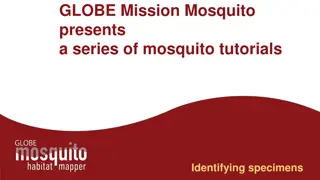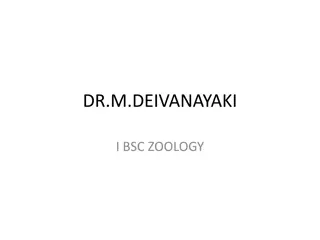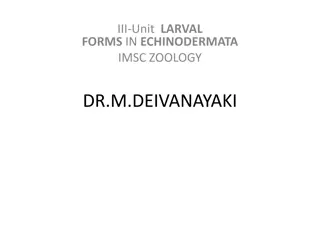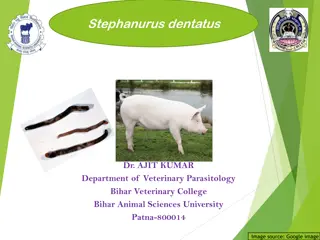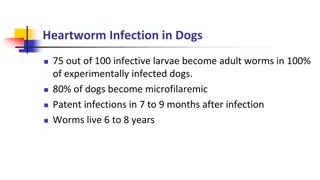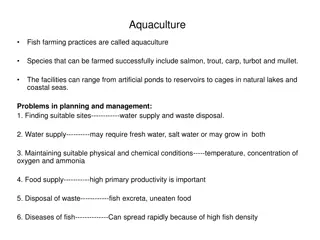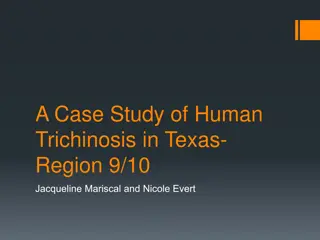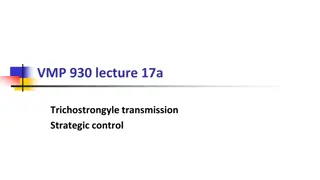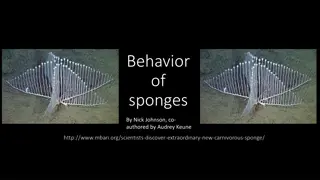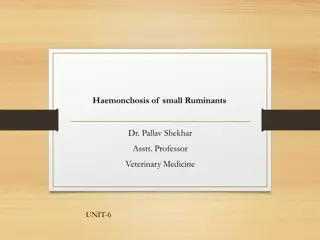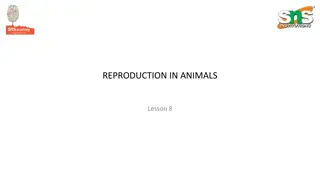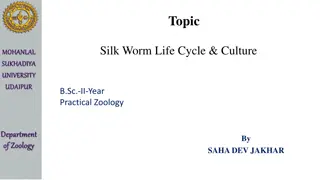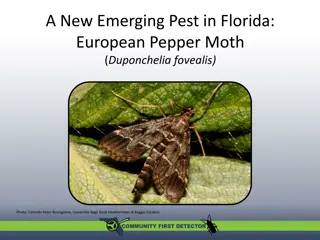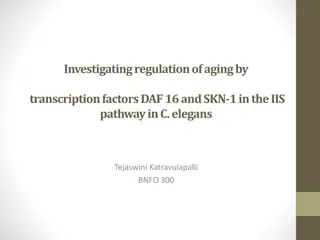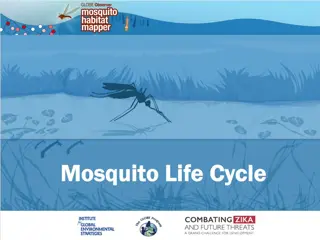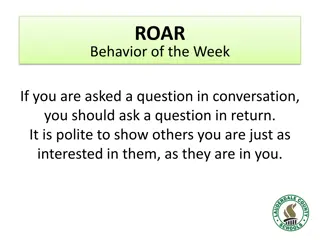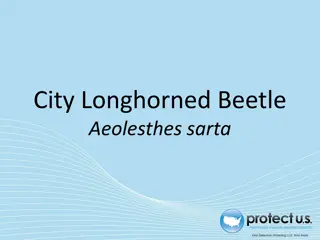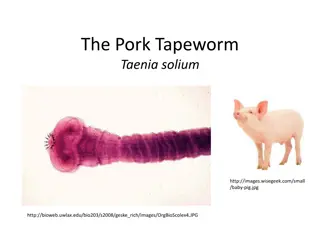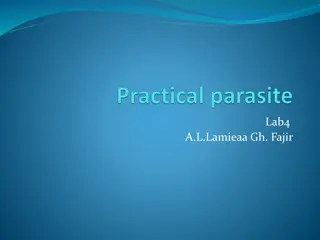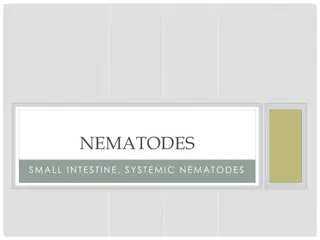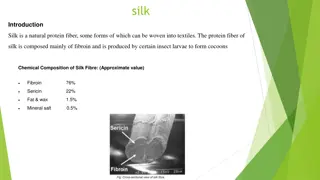Understanding Mosquito Larvae: Identification and Anatomy
Explore tutorials from GLOBE Mission Mosquito focusing on identifying mosquito larvae specimens including Anopheles, Aedes, and Culex genera. Learn about the morphological characteristics, habitats, and anatomy of mosquito larvae to understand their role as disease vectors. Detailed descriptions and
11 views • 22 slides
Larval Forms in Echinoderms: Development and Diversity
Echinoderms exhibit various larval forms as part of their life cycle, with different classes showcasing distinct types of larvae. These larvae undergo metamorphosis to transition into the characteristic radial symmetrical adults. The bipinnaria, brachiolaria, auricularia, and ophiopluteus larvae are
1 views • 8 slides
Larval Forms in Echinodermata: A Study of Development Stages
Echinoderms, as deuterostomes, exhibit radial and indeterminate cleavage. Their larvae undergo metamorphosis to become adults through various stages. Different classes of echinoderms have distinct larval forms, such as Bipinnaria, Brachiolaria, Auricularia, and more. These larvae display bilateral s
0 views • 8 slides
Understanding Stephanurus Dentatus: Kidney Worm of Pigs
Stephanurus dentatus is a parasitic worm that infects pigs, with an intricate life cycle involving earthworms as transport hosts. Transmission occurs through ingestion of larvae or infected earthworms, leading to various pathological effects, including subcutaneous nodules, cirrhosis, and organ dama
0 views • 13 slides
Understanding Heartworm Infection in Dogs
Heartworm infection in dogs is caused by infective larvae that mature into adult worms, leading to potential complications such as pulmonary arterial wall thickening and increased right heart pressure. Clinical signs may include tiredness, shortness of breath, and weight loss. Diagnosis involves ant
0 views • 9 slides
Challenges and Future Trends in Aquaculture Farming Practices
Aquaculture, or fish farming, involves farming species like salmon, trout, and carp in various facilities ranging from artificial ponds to coastal cages. Challenges in planning and management include finding suitable sites, maintaining water supply, ensuring proper physical and chemical conditions,
1 views • 4 slides
Case Study of Human Trichinosis in Texas Region
Human trichinosis is a parasitic disease caused by consuming undercooked or raw meat infected with Trichinella larvae. This case study details the presentation, diagnosis, and treatment of a 36-year-old female physician from San Angelo, Texas, who manifested symptoms after consuming bear meat from A
0 views • 22 slides
Honey Bee Exposure to Pesticides: Routes and Impacts
Analysis by the U.S. Environmental Protection Agency outlines various exposure routes of honey bees to pesticides, including contact with contaminated sources like foliage and soil, ingestion of contaminated pollen and nectar, and inhalation of chemical droplets. Different application types and age
2 views • 13 slides
Understanding Trichostrongyle Transmission and Strategic Control
Trichostrongyle transmission primarily occurs through pasture contamination with eggs shed by adult worm populations in grazing hosts. The development of infective larvae on pasture involves specific conditions like moisture and warmth, leading to different types of ostertagiasis infections. Various
0 views • 20 slides
Insights into the Behavior and Life Cycle of Sponges
Sponges exhibit unique behavior characteristics both externally and internally. They are sedentary organisms with cylindrical bodies that can be soft or hard, flexible or brittle. Sponges reproduce via sexual and asexual methods, and go through a life cycle from larvae to adulthood. Their reproducti
0 views • 6 slides
The Fascinating World of Sponges: Structure, Feeding, and Reproduction
Explore the incredible world of sponges, from their unique structure with tiny pores to their feeding habits straining food from water. Learn about sponge larvae, reproduction through sexual and asexual means, and discover the wonders of these ocean-dwelling organisms.
0 views • 8 slides
Understanding Haemonchosis in Small Ruminants
Haemonchosis is a significant disease affecting sheep and goats that is caused by blood-sucking parasites. This condition leads to anemia, debility, and pain in infected animals. The etiology involves various species of Haemonchus affecting different animals. Understanding the life cycle, characteri
0 views • 23 slides
Understanding Animal Reproduction: Key Concepts and Life Cycles
Exploring the fascinating world of animal reproduction, this lesson covers the basics of how animals produce offspring, including the parts of an egg, differences between tadpoles and adult frogs, stages in the life cycle of a cockroach, and distinctions between larvae and nymphs. It also delves int
0 views • 10 slides
Silk Worm Life Cycle and Culture at Mohanlal Sukhadiya University Udaipur
The life cycle of silk worms, particularly Bombyx mori, is detailed in this practical study conducted by the Department of Zoology at Mohanlal Sukhadiya University, Udaipur. The process from eggs to larvae, cocoon formation, and the emergence of the adult silk moth is explained. Silk worms feed on m
0 views • 13 slides
European Pepper Moth: A New Emerging Pest in Florida
The European Pepper Moth, native to coastal wetlands of the Mediterranean, has become a concern in Florida as a potential pest affecting various ornamental and agricultural plants. Its distribution in Florida is still being monitored, and it poses a threat to a range of susceptible plant species. Th
0 views • 21 slides
Investigating Regulation of Aging by Transcription Factors DAF-16 and SKN-1 in the IIS Pathway in C. elegans
Aging regulation in eukaryotic organisms, particularly in Caenorhabditis elegans, is studied through the Insulin/Insulin-like Growth Factor-1 Signaling pathway. This research focuses on understanding how transcription factors DAF-16 and SKN-1 may act together to promote longevity by reducing the IIS
0 views • 11 slides
Exploring the Fascinating Mosquito Life Cycle
Dive into the intriguing world of mosquitoes through images and informative descriptions discussing their life cycle stages, important vocabulary, and behaviors. Learn about how female mosquitoes lay eggs, where larvae hatch and develop, and how adult mosquitoes thrive in different environments. Exp
0 views • 16 slides
Enhance Conversations and Vocabulary with Word of the Day and ACT Practice Problems
Explore a weekly ROAR behavior tip emphasizing reciprocal questioning in interactions. Discover intriguing words of the day such as 'gauge,' 'hypothesis,' 'incremental,' 'larvae,' and 'mass,' along with sample sentences to grasp their meanings. Engage in ACT practice problems to boost your skills. U
0 views • 11 slides
City Longhorned Beetle - Aeolesthes sarta Overview
This article provides detailed information on the City Longhorned Beetle (Aeolesthes sarta), including its origin in Pakistan and Western India, common names, global distribution, potential presence in the United States, and impact as a pest on various trees. It covers identification of adults, pupa
0 views • 24 slides
The Strangest Foods Around the World
Discover some of the most bizarre and unique foods from different countries, including Wasps Crackers from Japan, Fried Spider from Cambodia, Escamol from Mexico, Beondegi from South Korea, Pickled Egg from the UK, Fugu from Japan, and Kangaroo from Australia. These unusual delicacies range from bis
0 views • 10 slides
Understanding the Pork Tapeworm, Taenia solium: Appearance, Lifecycle, and Reproduction
The pork tapeworm, Taenia solium, is a potentially dangerous flatworm to humans, with a white ribbon-like body that can grow up to 9 meters in length. This parasite has distinct body parts including the scolex, neck, and strobilia. Humans can get infected by ingesting larvae in measly pork, leading
0 views • 18 slides
Understanding Parasitic and Non-Parasitic Materials in Feces Examination
When examining feces for parasites, it's crucial to differentiate between parasitic material, non-parasitic material, and pseudoparasites. Recognizing parasite eggs and cysts based on their shape and size is essential for accurate identification. Additionally, being aware of non-parasitic materials
0 views • 7 slides
Overview of Intestinal Nematodes: Ascaris lumbricoides and Strongyloides stercoralis
Intestinal nematodes, including Ascaris lumbricoides and Strongyloides stercoralis, are common parasitic infections affecting the small intestine. Ascaris is a roundworm with a global distribution, transmitted via fecal-oral route or flies, while Strongyloides is a threadworm primarily found in trop
0 views • 24 slides
Exploring the Interconnected World of Owls and Larvae through Earth Science
Discover the intricate relationships between owls, larvae, and their ecosystems in this compelling Earth Science portfolio project by Alexis. Learn about food chains, cellular respiration, endangerment factors, and symbiotic relationships. Gain insights into the role of decomposers, environmental im
0 views • 11 slides
Understanding the Degumming Process in Silk Production
Silk is a natural protein fiber composed mainly of fibroin and produced by certain insect larvae. The chemical composition includes fibroin, sericin, fat, wax, and mineral salt. Sericin removal, known as degumming, is crucial for silk quality and involves processes like extraction with water, boil-o
0 views • 9 slides
